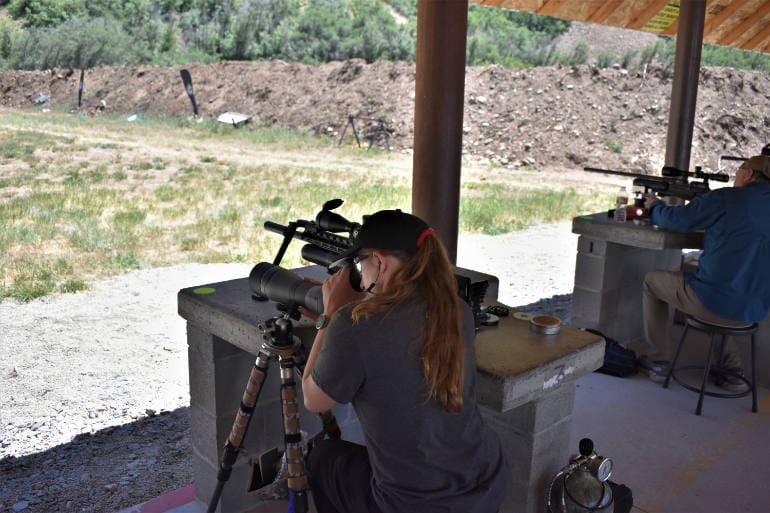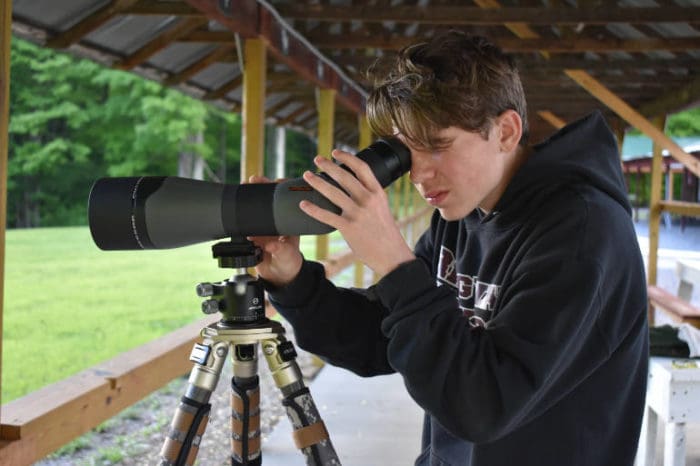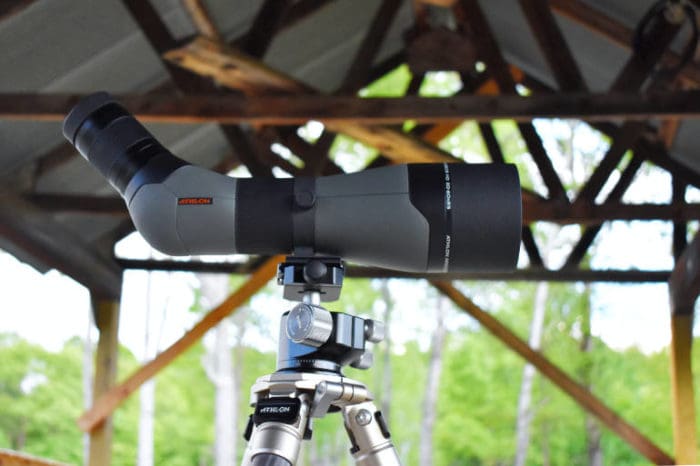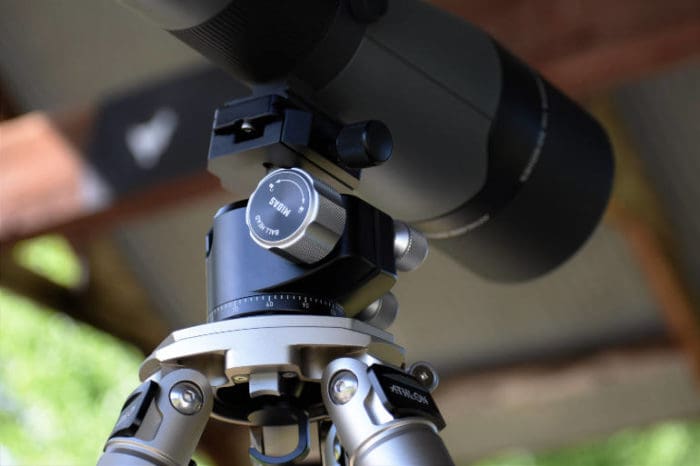
“Hey, can I see that?”
It’s pretty typical for fellow shooters to check out one another’s gear on the range. It’s a way to learn about products first-hand and ask another’s personal experience, all without spending any money.
Taking the Athlon Midas CF32 tripod and Argos 20-60×80 HD Spotting Scope to the range resulted in an astounding number of queries and a variety of interest.
Some were curious about the tripod. More were interested in the spotting scope. Others still were desperate for a method of seeing hits on target and either owned something without enough magnification, had nothing at all, or were completely unfamiliar with the concept of a spotting scope.
Stand or Tripod?
Spotting scopes are incredibly useful tools. I use them for viewing my target and watching wind conditions. I’ve always used a spotting scope stand and really appreciated the robustness and versatility of the Athlon Midas CF32 tripod.
Spotting scope stands and tripods have very different purposes. While both can and generally support a scope, stands are thin and tall, ideal for fitting in small places, like on a crowded firing line. They are perfect for offhand and positional shooting with multiple competitors shooting side by side with limited space for all their gear. Stands vary in stability, but ultimately, they just aren’t as strong as tripods.
Triangles are the strongest shape, and tripods are full of them. Some stands are composed of several hollow pieces that accommodate a cleaning rod when screwed together and are easily transported when taken apart.

Tripods don’t have space for a full-length cleaning rod, but they do have other uses. The Athlon Midas CF32 tripod’s three legs are wrapped in removable camo coverings. These slips make the tripod more comfortable to move and grasp, but with several straps on each, it’s easy for the user to securely attach a variety of MOLLE compatible pouches for extra storage.
The Midas also comes with a padded sling and shoulder pad for easy carrying. Most of the time, I just picked it up by the legs and moved it the short distance I needed to go, using the tripod hammock to store items I’d otherwise carry by hand.
On the Range
I primarily used the tripod at the Rocky Mountain Airgun Challenge and the 2022 Smallbore Silhouette Nationals in combination with the Argos 20-60×80 HD spotting scope.

For the former, I stored Creedmoor Sports shooting bags in the hammock, along with magazines and pellet tins. For the latter, it was a convenient place for a timer, ammunition block, box of Lapua Center-X and a board for marking shots. I had to be careful not to drop anything, but the heavy Creedmoor bags stayed put and even help further stabilize the tripod.
Argos 20-60×80 HD Spotting Scope Features
This spotting scope was by no means the smallest scope I’ve seen, but measuring 16.9” in length and 6.8” in height and weighing just over four pounds, it was still very portable and could fit in a carry-on suitcase. An easy-to-manipulate knob atop the scope allowed you to pivot the 45-degree eyepiece so you could easily view it when in position.
At the Rocky Mountain Airgun Challenge, I regularly shared the scope with at least one other spectator. While watching the 100-yard benchrest match, it was fun to watch the surprise as the other observer strained to look through the scope and I seemed to “magically” orient it to their side for easier viewing without changing the angle of the objective lens.
With so many people using it, I appreciated the twist up eye cup. Athlon recommends having the eyecup fully extended for best viewing without glasses, but I personally tended to keep the eyecup extended while wearing glasses to prevent them from scratching the glass or vice versa.

You have to get very close to see through the scope. Eye relief is about ¾”. I’ve long been spoiled with a long eye relief spotting scope and have found it to be a significant advantage in competition.
I struggled a bit during the benchrest match of the Rocky Mountain Airgun Challenge as I had to break position more than I would have liked to in order to look through the scope. This isn’t unusual as most spotting scopes don’t come with a long eye relief lens and many manufacturers have stopped offering it as an add-on.
The extendable sunshade over the objective lens was also a plus, though I didn’t find it critical.
Personally, I would have preferred a small knob for focus adjustment as opposed to the thick collar. Rotating the collar wasn’t difficult, but required purposeful force so it can’t be accidentally spun.
I had to grip the body of the scope with one hand and the collar with the other while adjusting focus so I could stay on target during the process. I had to do the same with the power change ring, but this was less critical as I wasn’t trying to find a perfect focus for seeing mirage and didn’t mind if I was a bit further off target.

I was very pleased with the clarity of this scope, especially for the price. As a variable power scope, the field of view decreased as I zoomed in. I’ve long used a fixed power Celestron with long eye relief so it took a bit of getting used to. The picture was slightly clearer at lower powers, but was still very good on 60x.
MIDAS CF32 Features
If you need more weight, the sturdy ball head features a counterweight hook on the bottom. The ball head itself offers great versatility and lots of adjustments including a friction control knob, fluid pan lock, and ball head lock.
A quick release plate is secured by a quick release locking knob. Removing the plate allows the plate base to accept ARCA-Swiss accessories and rails. One thing I quickly noticed is that the screw in the quick release plate often came undone. Hand-tight wasn’t enough. The best procedure was to tighten the screw with a coin each time I mounted the spotting scope on the tripod.

Built into the ball head quick-release base plate and socket are flat, circular bubble levels. I found these very helpful for ensuring I had the tripod and head level, especially when I mounted an FX Impact M3 on it.
The only flaw I found with this tripod was the glue holding the bubble levels in lost its grip after one or two range sessions. I spoke with Athlon about this and they assured me it had been corrected in later models as I have been testing one of the first ones.
The carbon fiber legs make the unit light and easy to carry, weighing 5.7 pounds. It’s capable of supporting up to 55 pounds. Leg angle catches offer a lowest extended height of nine inches while the leg extensions and locks allow for a maximum extended height of 65 inches.
The feet are interchangeable and the Midas comes with both rubber and spiked feet for varying conditions. I didn’t have any issues with just using the rubber feet. All was confidently enclosed in a easy to carry storage bag. Folded, the tripod measured 26 inches and easily fit inside a large suitcase for travel.
Specifications: Athlon Midas CF32 Carbon Fiber Tripod
Tripod (32mm tube), Ball Head
Head Style: Ballhead and Leveling Head
Head Mount: ARCA Compatible (Ballhead)
Leg Material: 10-Layer Carbon Fiber
Max Leg Diameter: 32mm
Maximum Extended Height: 65 inches
Lowest Extended Height: 9 inches
Folded Height: 26 inches
Weight: 5.7 lbs
Max Load: 55 lbs
MSRP: $724.99 (about $530 retail) with Lifetime Warranty
Ratings (out of five stars):
Reliability * * * *
The CF32 worked well among multiple different disciplines, uses, and terrains. I had only two qualms: the weak glue on the bubble levels and the fact that the screw on the quick release plate took significant force to stay tight. These are minor and easily fixed issues. Athlon representatives at the Rocky Mountain Airgun Challenge assured me the glue had been replaced after I received my test unit.
Ease of Use * * * * *
This tripod is incredibly intuitive and easy to use. There are several dials and various settings that can take a bit of experimentation, but nothing is overly complicated.
Versatility * * * * *
The ball head allows a spotting scope to be positioned in a variety of positions. It’s also easily swiveled to pan an area or to share with someone else watching. By nature, a tripod isn’t ideal for tight firing lines, but it is wonderful as a mobile shooting platform for rifles with ARCA rails.
Overall * * * * *
Even with the minor glue issue, I give this product five stars. I had never used a high-quality shooting tripod before and found myself choosing it over my spotting scope stand for a variety of applications. It was especially easy to transport and store.
Specifications: Argos 20-60×80 HD Spotting Scope – 45 degree
Magnification: 20-60x
FOV @ 1000 yards: 102 – 48 ft.
Eyepiece Angle: 45 Degrees
Weight: 70 oz.
Eye Relief: 0.7 – 0.70”
Dimension: 16.9 – 4.0”
MSRP: $487.49 (Approx $285 retail) with Lifetime Warranty
Ratings (out of five stars):
Clarity * * * *
This isn’t a Kowa or Nightforce, but its quality is more than adequate for the average shooter. Clarity was slightly better on lower magnification than on max.
Ease of Use * * * *
This scope is easy to use. I took off one star only because many people who borrowed the optic could not locate the focus ring as it was integral to the body. This was great for portability, but not something people generally figured out right away.
Portability * * * * *
The Argos was very easy to transport to and from the range as well as in a suitcase.
Overall * * * * ½
This scope offers a lot of features and versatility at a very affordable price. Most of the shooters who asked to borrow and look through the scope at the various matches I attended with it estimated the cost to be nearly double what it retails for.




I currently have 3 athlon scopes, and I love them. I will be getting this spotting scope.
I have used spotting scopes in the past.
But recently got a SME target camera for $189. Good out to 300yrds.
Works pretty good. I like the tracking your shots number feature.
They make a 1mile one too, for about $300.
Existing clothes repairing is a compulsory part of every home until you have enough money to purchase new clothes all the time. Even if you are stitching up a tear, hemming a pant, or re-attaching a button, it helps to have a way to make those repairs easily, accurately, and quickly. For this purpose, you’ll need a mechanical sewing machine in your home. So, having the best mechanical sewing machine is the finest way to keep your clothes looking enormous.
Guys, I’m a poor. I absolutely love that TriPod, but geeze LouEze, that’s a lotta jackmo for a TriPod. Can anyone recommend some other options for a lot less cheddah?
Thanks
The Athlon Midas CF32 tripod is an excellent choice for those who need a lightweight tripod that can support their heavy spotting scope. You need to check this fence paint nz and get more new tips for paints. It has durable aluminium legs and alloy feet, plus an anti-twist leg design that’ll prevent your scope from twisting in even the windiest conditions. It will also stop you from sliding around on the ground when using it for astrophotography.
erp indonesia
Comments are closed.